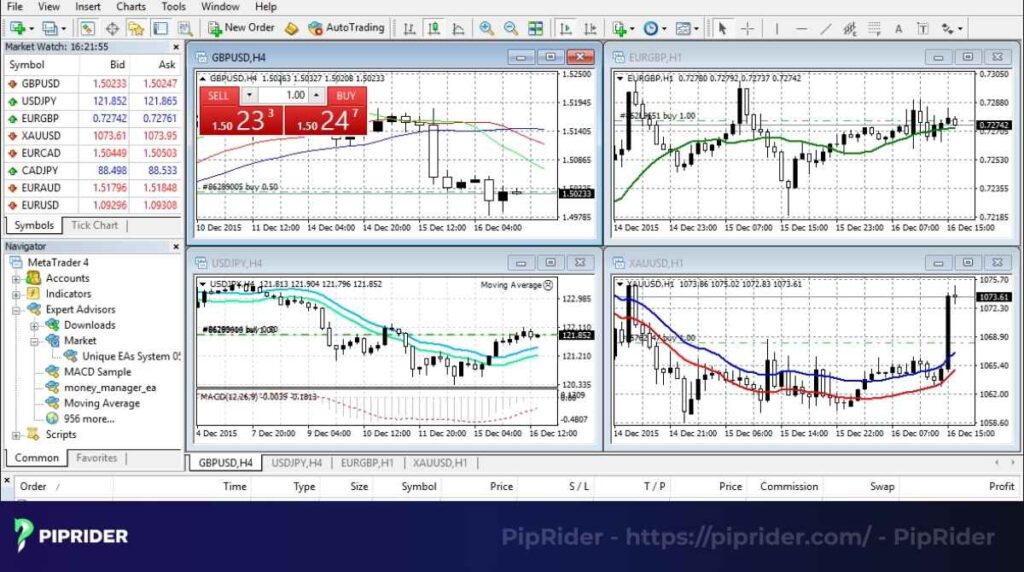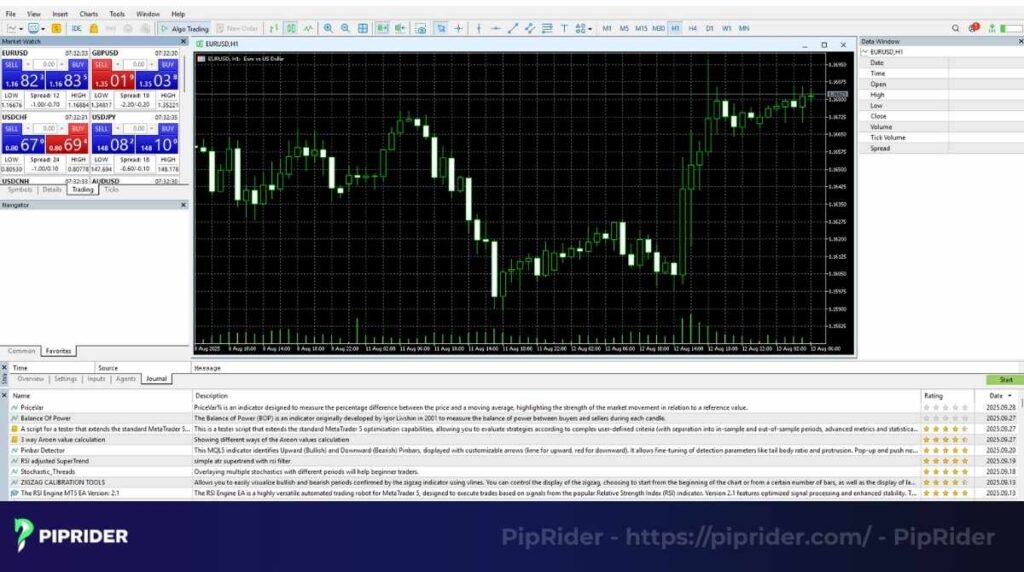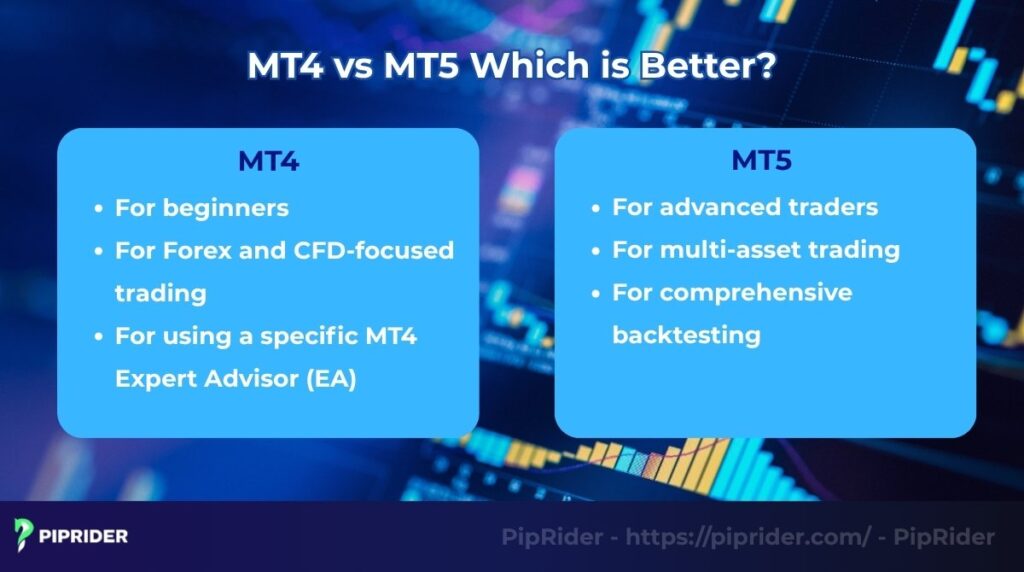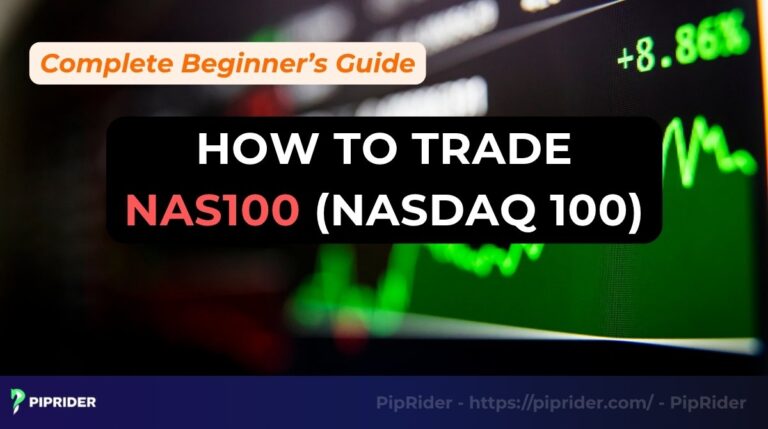MetaTrader 4 (MT4) and MetaTrader 5 (MT5) are two of the most popular trading platforms in the world, trusted by millions of traders. The choice between MT4 vs MT5 is often the first and most crucial decision for any trader, from beginners to professionals. This article will provide a detailed analysis of the key differences between these two platforms, helping you make an informed decision that aligns with your trading goals and strategies.
Key Takeaways
- MetaTrader 4 is a trading platform specifically focused on Forex and CFD trading, known for its familiar interface and large community.
- MetaTrader 5 supports multi-asset trading, including stocks, commodities, and futures, offering a wide range of assets to trade.
- MT5 offers more technical analysis tools, timeframes, and order types compared to MT4.
- The different programming languages mean that indicators and Expert Advisors (EAs) are not cross-compatible.
- The best choice of platform depends on the assets you want to trade and your specific trading strategy.
1. What Is the MetaTrader Platform?
The MetaTrader platform, developed by MetaQuotes Software, is a widely used electronic trading platform for online retail speculative trading. It acts as a bridge between traders and the financial markets, allowing you to view real-time market data, conduct technical analysis, and execute trades. The platform’s accessible interface and robust features have made it the industry standard, especially for forex trading and CFD trading (IG, n.d.).

MetaTrader’s popularity stems from several key factors:
- Comprehensive tools: It provides a vast array of tools for technical analysis, including interactive charts, a wide range of built-in indicators, and drawing tools.
- Automated trading: One of its most powerful features is the ability to support trading signals and automated trading through Expert Advisors (EAs). This allows traders to automate their strategies based on predefined rules.
- Accessibility: Both versions are available across multiple devices, including desktop, web, and mobile, providing flexibility for traders to manage their positions from anywhere.
- Lightweight software: The platforms are designed to be lightweight, ensuring fast trading and near-instantaneous execution without putting a heavy load on your computer.
The reliability and feature-rich environment of MetaTrader have solidified its position as the platform of choice for both retail traders and major brokers worldwide.
Read more:
What Are Pips in Forex? A Complete Guide for Traders
Forex Trading Terminology: The Ultimate A-Z Guide
2. What Is MetaTrader 4?
MetaQuotes Software launched MetaTrader 4 (MT4) in 2005, and it quickly became the go-to platform for online forex trading. While it can handle other instruments like CFDs on commodities and indices, its primary focus and strength lie in the market.

The platform’s widespread adoption is due to several key advantages:
- Intuitive and user-friendly interface: MT4’s layout is simple and easy to navigate, making it a perfect starting point for beginner traders. Its familiarity also means that experienced traders often stick with it.
- Extensive community and resources: Having been around for a long time, MT4 has a massive community of traders and developers. This means there’s a huge library of free and paid indicators, scripts, and Expert Advisors (EAs) readily available.
- Reliable performance: Known for its stability and efficiency, MT4 provides a dependable trading environment with fast execution speeds, a crucial factor in the volatile market.
The platform’s robust features and strong support network have cemented its legacy as the undisputed king of forex trading for over a decade.
3. What Is MetaTrader 5?
MetaQuotes Software released MetaTrader 5 (MT5) in 2010, developing it as an updated, multi-asset platform. While MT4 was specifically built for forex, MT5 was designed to cater to a broader range of financial markets.

The key distinction of MT5 is its ability to handle multi-asset trading, providing users with expanded market access. This expanded functionality comes with a suite of advanced features compared to its predecessor:
- Expanded charting & Analysis: MT5 provides significantly more timeframes (21 vs. 9) and technical indicators (38 vs. 30), giving traders more detailed options for charting and market analysis.
- Advanced order management: It introduces two additional order types: Buy Stop Limit and Sell Stop Limit, and supports both hedging and netting systems for position management.
- Enhanced backtesting: The platform features a multi-threaded, multi-currency strategy tester, which allows for faster and more comprehensive back-testing of automated strategies.
- Built-in tools: MT5 includes a built-in economic calendar and a Depth of Market (DOM) feature, which provides insight into market liquidity and order flow.
Despite its powerful capabilities, MT5 has been slower to gain widespread adoption, primarily due to the ingrained popularity of MT4 and the lack of backward compatibility with MT4’s MQL4.
4. Difference between MT4 and MT5
| Feature | MetaTrader 4 | MetaTrader 5 |
| Asset Classes | Primarily Forex & CFDs | Multi-asset (Forex, CFDs, Stocks, Futures, Options) |
| Timeframes | 9 | 21 |
| Technical Indicators | 30 built-in | 38 built-in |
| Graphical Objects | 31 | 44 |
| Pending Order Types | 4 (Buy Limit, Sell Limit, Buy Stop, Sell Stop) | 6 (includes Buy Stop Limit, Sell Stop Limit) |
| Programming Language | MQL4 | MQL5 |
| Backtesting | Single-threaded | Multi-threaded, multi-currency |
| Built-in Features | N/A | Economic Calendar, Depth of Market |
| Position Management | Hedging only | Hedging and Netting |
While the table above provides a quick summary, the following sections will delve into each of these key differences in detail for a more comprehensive understanding of each platform.
4.1. Market Coverage and Asset Classes
The most fundamental difference is their target markets. MT4 was built primarily as a dedicated forex trading platform for the forex and CFD trading market, focusing on simplicity and speed.
In contrast, MT5 was developed as a multi-asset platform, supporting not only currencies but also providing direct access to centralized exchanges for stocks, futures, cryptocurrencies, and options. This makes MT5 the more versatile choice for traders who want to diversify their portfolios.
4.2. Order Types and Execution
MetaTrader 4 provides a standard set of four pending types, which is sufficient for most trading strategies. MT5 offers a more advanced set of six pending types, including the Buy Stop Limit and Sell Stop Limit, which allow for more precise entries. Additionally, MT5 provides flexible order-filling policies and supports both a hedging system and a netting system, giving professional traders greater control over their positions and forex lot sizes.
4.3. Charting and Timeframes
MetaTrader 4 offers a basic but effective range of nine timeframes, from one-minute to monthly charts. MT5, however, significantly expands on this with 21 different timeframes. This wider range includes more granular intervals like 2-minute and 8-hour charts, giving traders greater flexibility to analyze price movements across various time periods.
4.4. Technical Tools
The number and variety of technical tools differ significantly. While MT4 comes with 30 built-in indicators and 31 graphical objects, traders often rely on the MQL4 community for custom tools. MT5 offers a more extensive suite of 38 built-in tools and 44 graphical objects, along with an integrated Economic Calendar and a Depth of Market (DOM) feature, making it a more robust platform for in-depth analysis.
4.5. Programming Language: MQL4 vs MQL5
MQL4 is an older, structured language with a massive library of existing EAs and indicators. MQL5 is an updated, object-oriented language that is more powerful and efficient for building complex, high-performance automated strategies. A crucial point is that EAs and indicators written for one platform will not work on the other.
4.6. Backtesting: Single-thread vs Multi-thread
A significant advancement in MT5 is its improved backtesting capability. MT4 uses a single-threaded backtester, which can be slow, especially when testing complex strategies on large datasets. MT5 features a more powerful, multi-threaded backtester that can analyze multiple currency pairs simultaneously, providing significantly faster and more accurate results for optimizing EAs.
4.7. Community and Broker Support
MT4 has a massive, long-established community and is the industry standard, making it widely offered by almost all brokers. MT5’s community is smaller but growing, focusing more on advanced programming and features. While fewer brokers initially offered MT5, its support is rapidly increasing as the platform gains wider adoption, particularly among those who want to provide a multi-asset trading solution.
5. Metatrader 4 and 5: Pros and Cons
Both platforms have distinct advantages and disadvantages that cater to different types of traders. Here’s a concise summary to help you decide which is better for your trading style.
| Platform | Pros | Cons |
| MetaTrader 4 | – Ideal for beginners due to its simple interface. – Extensive, long-established community and vast library of free resources (EAs, custom tools). – Perfect for traders focused exclusively on forex and CFD trading. | – Limited assets, timeframes, and built-in tools. – Slower, single-threaded backtesting. – No multi-asset support. |
| MetaTrader 5 | – Designed for multi-asset trading (stocks, futures, cryptocurrencies, etc.). – More powerful tools (more timeframes, custom tools, etc.). – Faster, multi-threaded strategy tester for strategy optimization. – Modern MQL5 for complex EAs. | – Smaller community and fewer free resources than MT4. – No backward compatibility with MT4’s EAs and indicators. – Can be overwhelming for new traders. |
This table clearly shows the difference between MT4 and 5, but to put it simply:
MT4 is best for beginners and dedicated traders. Its straightforward interface and wealth of community-created resources make it an excellent starting point for those new to the market.
MT5 is better for advanced traders and those who trade multiple asset classes. Its expanded features, faster backtesting, and support for a wider range of instruments make it a powerful tool for professionals seeking a more comprehensive solution.
6. MT4 vs MT5: Which is Better?
The decision between MT4 and MT5 ultimately depends on one’s trading goals and experience level. The following recommendations provide a clear guide to making the right choice.

Choose MT4 if:
- For beginners: Its simple interface and robust community make it an ideal starting point for those new to trading.
- For Forex and CFD-focused trading: If trading strategies are centered solely on currency pairs and contracts for difference, MT4 offers the required functionality with a streamlined interface designed specifically for this market segment.
- For using a specific MT4 Expert Advisor (EA): Many popular EAs and indicators are built on MQL4, making MT4 the only option for using them.
Choose MT5 if:
- For advanced traders: MT5 is a more powerful, modern platform designed for professional use, offering advanced features for greater control and analytical power.
- For multi-asset trading: For traders who plan to diversify portfolios to include stocks, futures, or options, MT5 is the only platform that offers access to these centralized exchanges.
- For comprehensive backtesting: The multi-threaded backtester on MT5 is a significant advantage for traders who require data-heavy strategy optimization and analysis.
7. FAQs
8. Conclusion
The choice between MT4 vs MT5 is a question of needs. MT4 is the ideal platform for beginners and traders focused on the forex market, thanks to its accessible interface and massive support community. In contrast, MT5 is the superior, all-in-one solution for advanced traders who need access to more tools, trading different assets, and faster power. The best path for a new trader is to start with MT4 and transition to MT5 as their experience grows.
To learn more about various platforms and tools, explore other articles on the Piprider blog in the Learn Forex & Beginner section.








